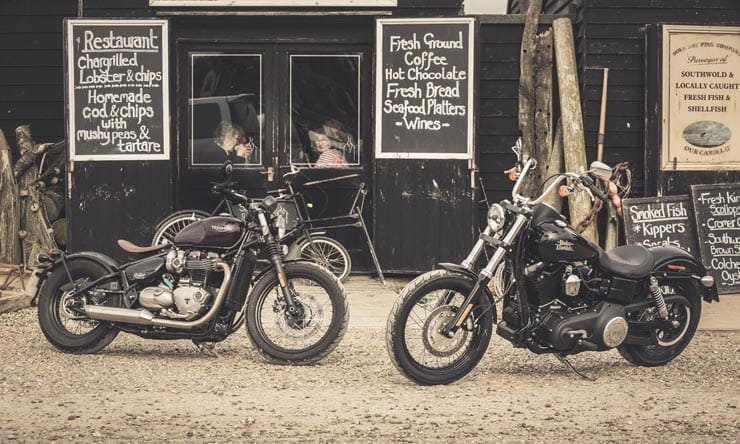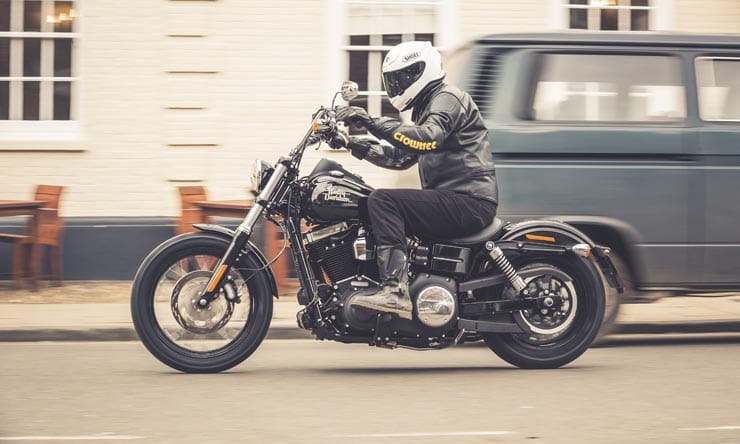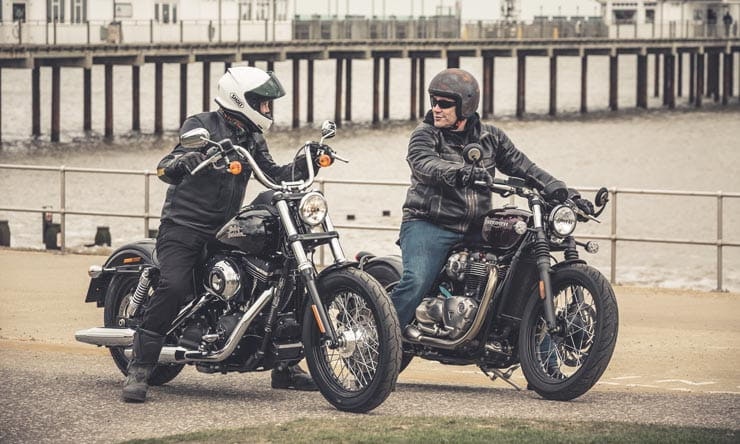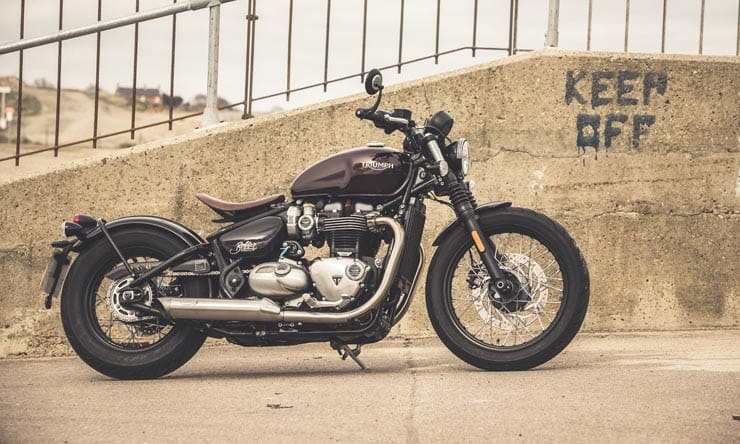Bobbing and weaving: Triumph Bonneville Bobber vs Harley-Davidson Street Bob
By Steve Rose
BikeSocial Publisher since January 2017.
28.03.2017
Triumph’s new Bobber takes the factory custom bike to a new place. BikeSocial takes it (and a Harley) to Norfolk...
127 miles into a 130-mile ride home from Norfolk I start making a list. The five things even less comfortable than riding a Triumph Bobber for 130 miles.
Riding a horse for 130 miles
Riding a mountain bike with flat tyres on gravel for 130 miles
Being dragged along a cobbled road on a rope tied to the back of a Transit van for 130 miles
Er, that’s it. I can’t think of anything else less comfortable than riding 130 miles on a Bobber. Unless you count ‘riding 140 miles’ on one, which would definitely be worse.
Don’t get me wrong. I love this bike. In many ways, it is the best bike in Triumph’s range. Even prettier in real life than the photos, built like a bike costing twice the money and easier to ride than any custom bike in history…ever. If MV Agusta had unveiled the Bobber we’d have all been coo-ing and fawning over the adventurous, innovative, boundary-pushing design (and that would just be the seat). Make no mistake, this is a landmark motorcycle and it rides as well as it looks.
It turns out that the seat on our test bike is the optional ‘statement’ item from the range of over 150 official Triumph Bobber accessories. I have a ‘statement’ about the seat and what it does for blood flow to the part of my anatomy once ingloriously described as the ‘biffing skin’, but it’s probably best reserved for those with their laptop’s parental controls set to ‘Mary Whitehouse’.
I’m sure that either of the other two available seats (ribbed or quilted) would be more comfortable, but this one looks the coolest. And besides, this was never a bike designed for spending a couple of hours at a time in the saddle. It’s the first rule of custom biking; no journey longer than 63 minutes without a decent break and never have to be anywhere by a certain time.
Understand that and buying a Bobber will change your world. Next to the Harley it looks tiny, almost toy-like. With a seat height of just 690mm and a slim fuel tank, even the shortest riders will feel confident and the Triumph feels like it weighs a fraction of its actual 228kg (the same as Honda’s Africa Twin, which U-turns like a drunken giraffe by comparison).
Of course, all the styling in the world is worthless if the riding experience is limp and woolly as factory custom bikes can sometimes be. The essence of bobbing is a four-letter word; Blat. A simple fantasy – short, sharp bursts of acceleration, splitting traffic, misbehaving, but never-quite nasty. Fonzie, not frettenin’.
Triumph understand this. The Bobber’s engine is a detuned, torquier version of the latest, water-cooled, T120 Bonneville; 10% less peak power, but stronger in the midrange. It works too, especially in the lower gears where acceleration to 60mph is satisfyingly strong. The clutch is light and each gearchange is slick (compared to the Harley), if deliberate.
In the higher gears Bob feels less sharp, like he’s been geared for top speed rather than acceleration. Swapping 60mph for 70 or 80 takes longer than you’d expect from a 1200cc twin and riding into a headwind feels like someone hooked a bungee to the mudguard.
Ok, so this is a bruiser, not a cruiser – the coolest urban transport yet. Blat, Blam, slice, screech…stop. Ride to the soundtrack of ‘Leader of the Pack’, it’s a very square peg in the ‘normal riding’ hole. Except that, being a Triumph you know it’ll handle – there’s something in the water at Hinckley that builds easy steering and confident cornering into everything they do. I was eight miles into my favourite ten-mile stretch of fast, twisting A-road, slack-jawed at how easily the Bobber was dealing with 80mph corners before I remembered that it was raining and the road, while not exactly soaked, was definitely more-than-damp. Thank you Triumph. Thank you Avon Cobra tyres.
Riding the Harley on the bumpy, Norfolk backroads from Bury St Edmunds to Southwold, it was interesting watching fellow tester, Kane Dalton, on the Bobber. When he was behind, a glance in my mirrors revealed a hunched figure on a tiny bike looking about as cool and menacing as any distilled motorcycling stereotype – beautiful. When he came past on a faster bumpy, twisty section the image withers a little. Side on, with a rider, the Bobber looks unfinished and home-built (maybe that’s a compliment) and following him, mesmerised by the back wheel moving up and down while the seat stays still, was just plain weird. But it did give an indication of how much easier the Triumph handles than the Harley. The Bobber looked smooth and ‘together’ where the Street Bob felt like arms, eyes and legs all windmilling against each other.
And in Southwold’s narrow backstreets the Bobber was much easier to get through traffic, turn on a fivepence and ride with confidence when the road turned to deep potholes and gravel.
So, performance is good, handling is excellent and the grown-up stuff like switchgear and build quality is everything you’d expect on a top-spec machine. I particularly like the oversized, Vincent-esque speedo – shame that they didn’t build in a modern ‘chronometric’ action like the originals (Smiths chronometric speedos fitted to most old British bikes worked on a kind of clock mechanism and actually ‘ticked’ their way around the dial in a wonderfully hypnotic manner). Fuel consumption is ok, averaging 55mpg, giving a theoretical range of 110 miles from the two-gallon tank, although in practice, you are looking for fuel at 70 miles when the light pops on.
At £10,500 it’s pricey for a Bonneville, but cheap for something this well built, this cool and this capable. I’m going to stick my neck out here and say that this is the best (and bravest) bike Triumph have built yet. Obviously the Speed and Street Triples are better dynamically, the Tigers are more ad-ven-chewer-us, but all of those are machines available in other flavours from KTM, Yamaha, BMW etc.
The Bobber is unique in being a factory custom bike that’s almost certainly cooler than a genuine custom machine and it works as a bike too…for 63 minutes at a time.
Triumph Bobber ingredients
Take one state-of-the-art, water-cooled 1200cc parallel twin engine, give it a 270-degree firing order so it throbs like a wanabbee-vee and tune it for Harley-slaying, low-down urban assault and blattery.
Shoehorn it into a simple-but-competent cut-down chassis with a very low seat, short-travel suspension, adequate brakes and steering geometry on the lazy side of sporty, but sporty side of cruisey.
Make sure it runs on proper, grippy tyres and add some simple electronic aids; single-stage traction control, road and rain engine mapping and ABS brakes and then let someone style it who gets what makes these bikes special.
Don’t be afraid to make it too focused, don’t retreat into everyman thinking and don’t build it down to a price.
Harley Davidson Street Bob
The bloke in the fancy car is trying to look unflustered. He needn’t worry - obviously a decent driver and his car (some kind of sporty two-door BMW M-thing) is quick. But he’s not enjoying having a high-barred Harley on his tail and while neither of us are pushing our limits, it’s been an entertaining few miles – we’ll call it a draw.
Ok, honesty first. I love Harleys. It took a while, but I ‘get’ em. Riding a Milwaukee bike is like wearing a Xmas jumper, you have to be able to laugh at yourself, while riding it well enough to maintain bragging rights for your ‘about-to-be-battered’ ego. Because mainstream motorcycling still laughs at Harleys, even though they’ve been fast enough, sharp enough and good enough for at least ten years now.
This one, the Street Bob, is the cheapest (£12,245) and most basic spec’d bike with the bigger Harley engine, although it’s not the water-cooled one or the latest 108cubic inches. I don’t understand cubic inches and my hurried mobile maths following Bee-em-man gives the Harley a capacity of 1650cc (it’s actually 1687cc… good job they don’t conduct O-levels on the B1190).
To be honest, this engine is starting to show its age. Our one was very new with just 27 miles on the clock when we picked it up. I put a hundred gentle miles on the bores before the test to loosen it up and it still felt a little tight. But after the Triumph, there’s not enough revs and too slow to find them. Packing an extra 80kg doesn’t help. A few years back Harley had the ‘big, lazy twin’ market mostly to themselves, but these days there are a few noisy upstarts, pushing development along.
So…road testing a Harley. Here we go again. Spec wise, it’s simple. Two cylinders, air-cooled, the world’s largest gearbox casing (what do they put inside there?). ABS on the single front and rear disc brakes, no traction control, no multiple riding modes, no suspension adjustment and no pillion seat. There’s a fancy keyless ignition and built-in alarm, but no lock on the fuel cap. Objects in the mirrors are less blurry than they appear.
It’s hard to make comparisons. The Bobber accelerates faster, has a similar top speed, is more confident in corners, but the ride quality over bumps is noticeably worse (riding a bumpy road on the Triumph reminds me of a cartoon bloke falling down a cliff, hitting every bump on the way – ‘Ow…Ooww, Oww…repeat loudly and laugh’).
The Harley goes twice as far on a tank of gas (because the tank’s twice as big), weighs 30% more, is every bit as entertaining to ride and much more comfortable. Side by side the Triumph looks like a factory-finished, complete, designer motorcycle, where the Harley looks a bit more rough-and-ready. Less designed, more ‘built’. One of them is an iPod, where the other is a gramophone.
Which is a little unfair because, under the skin, there’s a lot more high-tech in the Harley than you’d think and that, in conjunction with steady improvements to the chassis and running gear is what’s brought Harley performance to a standard where mischievous middle-aged blokes can go harassing German tin-tops on their way to work.
As always the H-D test bike challenge is to make the most of the handling without destroying the footrests and that means adapting to the Milwaukee cornering technique; brake early, release brakes early, let suspension settle and then tip into the corner. Doing this keeps pegs away from tarmac for as long as possible. Our test bike was kindly loaned by Newmarket Harley-Davidson, one day it will be bought by a customer and I want them to enjoy it all, including the footpeg ends.
Ridden like this, the Street Bob handles well in medium-speed turns. In slower, tighter corners you’re fighting against the mass and lengthy wheelbase and in faster (80mph-plus) sweepers, there’s a gentle weave that never gets worse, but doesn’t go away either.
Kane, who owns a Street Bob alongside his Yamaha R1-M and Ducati 996 and who has a different take on life to me sees it more simply. ‘The Triumph is brilliant to ride, but it looks like a toy in comparison. The Harley is a full-sized motorcycle, needing some effort to ride it well.’ He’s right. The Bobber is a little ‘Shoreditch’ while the Harley is definitely more ‘Sheffield…circa 1978’ and which one you prefer will be entirely personal – nothing I can say will alter that.
Truth is that both are just as much fun to ride, both get loads of attention from non-riders, but only the Triumph is cool with other motorcyclists. If that matters, buy the Bobber. If not, go with your gut feel. In the end it’s the only way to choose a bike like this.
Sorry, that’s not very helpful, I know. Thirteen minutes of your life and no flipping verdict. Next week; BikeSocial tell you how to not choose a 1000cc super-naked. Apologies.
Harley Street Bob ingredients
Start with your biggest (1690cc) old-school air-cooled V-twin motor, tuned for torque (92 lb-ft), not power (H-D don’t quote power figures) and fuelled perfectly by sequential port fuel injection. Make sure the gearbox is mechanical enough to make every gearchange memorable, without being too difficult and don’t forget to engineer in a light clutch action and just enough throb that the bike feels almost alive when idling.
Build a chassis that suits the purpose, goes round corners and has suspension that soaks up the bumps, but still feels a little like a hardtail. Styling is simple – make it look like a Harley, with mid-level apehanger bars. Brakes need to be adequate and the ABS takes care of those times when gravity overcomes 304kg of Milwaukee steel.
Don’t forget that the standard bike is a blank canvas and no one leaves the dealer without a few tasteful accessories fitted.
The real deal
If the two bikes above are a little too ‘factory’ but you (like the BikeSocial team) have the engineering prowess of a teapot, then we’d suggest a trip to Krazy Horse Customs in Bury St Edmunds. Krazy Horse carry a stock or ready-to-roll custom bikes including the beautiful range from American specialists Zero Engineering.
We called in for breakfast and Kane, being a persuasive kind of chap, somehow wangled a quick ride on a Zero Type 5. What follows is a world record in motorcycle journalism – the shortest road test ever. Try not to blink or you’ll miss it.
This is not a road test. We did less than five miles on the Zero (our choice through lack of time – Krazy Horse were happy for us to have it for longer…and we’ll be back for a longer ride in a few weeks). However, you’d be surprised how much you can learn in a short time. Like how much faster a bike feels when you gain a few bhp and lose 100kg. The Zero is a proper bobber; no fat, no frills, no pesky Euro-spec emissions stuff weighing it down. So, open the throttle and it picks up and goes.
With no rear suspension, you get the most direct drive from spark plug to rear tyre. This is the real deal traffic light racer. All noise and nought-to-forty. There’s no steering lock to speak of, even less comfort than the Triumph and mirrors that show the inside of your knees and that’s all.
None of which matters because this is not a Ford Focus. It’s not meant to be functional, but a rolling, screaming piece of engineering art that tells the world you are not like them. This is a bike that you buy because you’ve already owned everything else. You might not ride it much, but every trip is memorable and this one is a keeper.
In a world where ordinary people spend £1000s on a home cinema or hot tub or fancy kitchen, £17,995 for a Zero Type 5 is a bargain. I know people who spent more than that on a horse and they’re much less practical than one of these.
That’s it. No more words, just look at the pictures instead. Soak up the detail, lift up your phone and call Krazy Horse now 01284 749645 before Kane buys them all.



